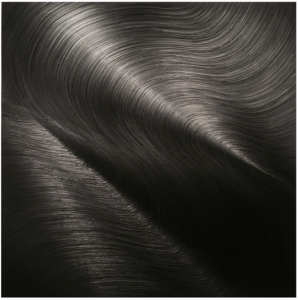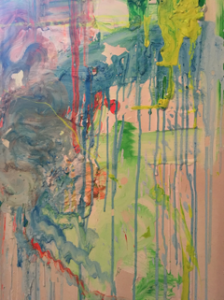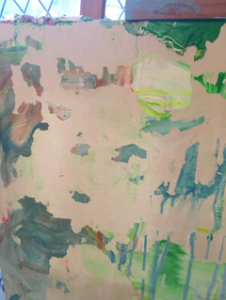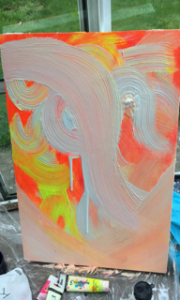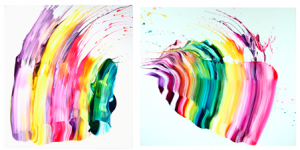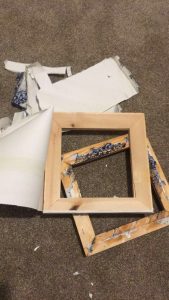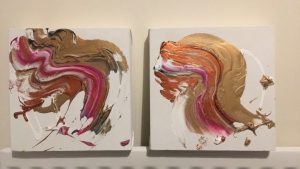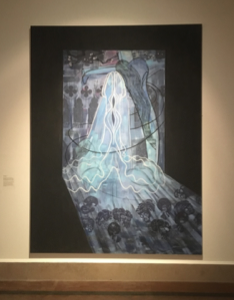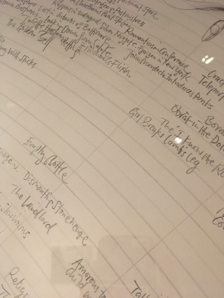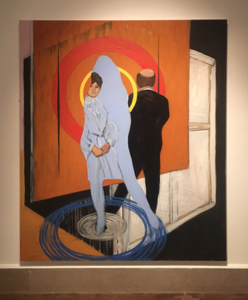Tempest Tossed (2017) is a 48×48 inch painting by James Austin Murray. By using just Ivory black oil paint on canvas and a large, handmade, squeegee-like brush tool, he creates huge swirling marks. Echoing the practice of Gerhard Richter and James Nares, his work is an exploration in process, light and material. He also makes prints with this surface, changing movements on the canvas and recording the relief onto linen. In terms of making this in a smaller scale, I would choose a 4×4 inch or smaller piece of MDF/wood/canvas and use a small amount of oil paint. Black definitely works the best as it absorbs and reflects the most amount of light. I could either make myself my own paintbrush/tool with tiny bits of twig tied together (or use a toothbrush) to create marks in the paint. I would then take a piece of canvas linen to create the same relief prints. An advantage of this descaling would be that the item being painted is a lot more tangible and portable, so more repetitions can be made on that linen surface or any other surface for that matter. More choices. On the other hand, the issue with it being so small is the fact that it lacks the grandeur that Murray’s pieces exude. There is far less material used, therefore cheap to execute. A smaller scale also comes with a more experimental action than that of Murray’s huge, laborious movements/process.
Author Archives: Lauren Williams
Task 11
My blog posts have been a useful exploration and introduction into some art theories, movements, artists and essays that I wouldn’t of otherwise thought about looking at before to support my work. This has been a weekly enriching task for me, exercising my research and organisation skills.
A task that I found useful in particular was task 5, writing about a piece of artwork I had seen in person. It was enjoyable writing about my favourite piece of artwork and arguing about the importance of seeing a piece of artwork ‘in the flesh’. I always find that writing about artists and issues is always good practice, which I enjoy. One thing that I struggled with in these blog tasks was the fact I was getting distracted while researching some elements, especially in task 7 comparing texts. I ended up looking at different concepts and artists that came to rise in the 70s. Getting distracted is a blessing and a curse, as on the one hand it’s fun to lose myself in something I’m interested in for a minute, but everything ends up taking a lot longer than planned.
Task 10
Repetition
Reproduce
Swirl
Chance
Intention
Colour
Control
Aesthetic
Discussion
Abstract
My practice involves exploration of the physically/materiality of paint and the act of painting, which is why I used the words chance and intention, abstract. I also like the idea of collecting, and repeating, working with materials and results at hand, which is why I used the word repetition and reproduce. Colour, aesthetic and swirl describes my style of painting however intentional or unintentional I try, my work always takes on a playful, pretty aesthetic. I used the word discussion because I like to hear the discussion around one of my abstract pieces, I like reaction bad or good. I like to hear what thoughts and questions it brings up.
Task 7
The Yale Lecture was developed by Richard Serra from notes after an abandoned sculpture project back in the mid-1980s, Slight Point. This lecture was given in the wake of a similar issue involving his work Tilted Arc. It was removed from the Federal Plaza in New York by a government agency and destroyed after it was deemed to be lacking in ‘aesthetic appeal’. It was debated widely after speculation of it being an ‘act of censorship’ and ‘suppression of speech’. Serra discusses his practice, inspired by the steel mines he worked in at the age of 17 to fund his studies. His site-specific work and its materiality/physicality speaks for itself, it is also heavily dependent on the social and political context in which the work will be/is placed. He believes that the works scale, size and location of the sculpture should be determined by the topography of the site. Compared to that of modernist sculpture, transportable and lacking context. Calling them ‘follies’, he humorously finds similarity in an iron deer on a front lawn, explaining that modernist sculpture is too commonly autonomous with its surroundings. Merely functioning ‘critically in relation to the language of its own medium’.
In an excerpt from Leo Steinberg’s Other Criteria, published in 1972, he discusses the subject of what he calls ‘The Flatbed Picture Plane’. The 70s is the decade that signified a huge shift within the art world. There was a strong sense of rebellion, and need for change. Contemporary Art is said to have started around this time. It was the decade of body art (Gutai), installation art, the conceptual, minimalism, performance art and the rise of feminist art after Linda Nochlin’s article Why have there been no Great Women Artists?, published in Art News in 1971. In one of the best essays on Robert Rauschenberg, Steinberg refers to the artist’s ‘Flat-bed picture plane’, borrowing the term from the flatbed printing press. He describes how Rauschenberg tacks pictures and material on a flat surface as one would with a bulletin board, and how people tack maps or horseshoes on the wall. He describes the flat bed picture plane as a ‘receptor surface’ in which objects are scattered. Steinberg also discusses how the picture plane is an upright, vertical surface that over a huge amount of time has survived even the biggest changes of art style (Willem DeKooning, Rothko etc.), still confronting the human posture, head at the top, foot at the bottom.
In terms of comparison of these two pieces, both explore the idea of change within their field. For instance, from what was said in Serra’s lecture, it is clear that his work embodies the change in which contemporary sculpture had created. It became much more conceptual, well within the context of the sculpture’s location whilst still celebrating its materiality. Steinberg also mentions Duchamp and his paintings in which flat, vertical picture plane becomes horizontal, a whole new viewing experience after the tradition of upright vertical surface lasted so long.
Harrison, C. and Wood, P. (2001) Art in theory, 1900-1990. Oxford, UK: Blackwell, pp. 948-953, 1124-1127
Task 1
Change has been a recent theme in my work, During the summer, I had been working on an ongoing paining project. Starting with a sudden realisation that the process of preparing for one of my paintings has created some sort of metaphor for my current life situation at the time. I made the difficult decision to drop out of Falmouth University back in February. It was hard thinking about the amount of amazing people I had met, how Cornwall is such a lovely place to live and how I didn’t want to disappoint anyone by dropping out, like I had given up. But the course just wasn’t for me, I constantly worries about money and my mental health was declining rapidly. So, I had to sacrifice a few things for the benefit my future, no matter how scared of debt or reapplying for university I was.
So, I was sat scraping away at one the artworks I made back in my foundation year, worrying about how easily the plaster and paint would come off and whether it was really worth it. Truth is, the paint was slowly falling apart in the corner of my room anyway. Bits of dusty material kept falling on the carpet as a brushed past it daily.
What I’m getting at is if you don’t like what you’re seeing in your life and want to change it, then change it. Even if you’re scared to. Some of the paint took more effort to scrape and some not at all. It’s bits of the past you can’t change, but you work a little harder to create a new surface to paint over.
I then created a few newer paintings using the same sturdy frame and a new layer of canvas, this process of recovering/painting over can now bring up new ideas for me of how my work is produced in terms of exhaustion of material, entropy/history.
Task 9
Colourfall: Spectroscopic (2013) is acrylic paint mounted on aluminium panel, Ian Davenport created this using nothing less than syringes full of paint, systematically pouring them down the surface. With the panels tilted slightly, gravity and consistency of the paint determines the final result of the painting. In my opinion, there is no theoretical reasoning behind his work other than the constant discussion of chance and intention. One could argue that it is pure chance in where and how the paint falls down the surface, especially at the bottom. But it could be the intention of using syringes with thin amount of paint and a steady hand in order to ensure a smooth line. The angle in which the panel is tilted is also under control of the artist to achieve some sort of desired outcome. I enjoy the fact that that Davenport’s work seems to be, arguably, isolated from the main political and social issues explored within the contemporary art world. His work has a conversation with its own materiality rather than the world around it.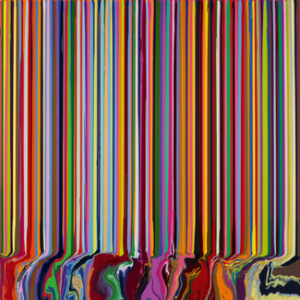
Task 8
Appropriation in art refers to the intentional use of pre-existing objects or works of other artists with little or no change from the originals. For this task, I have decided to appropriate one of my favourite artist Yago Hortal’s pieces, SP90 and SP84 (2015), and make a diptych with this. As an interesting process to start with, I had to rip apart one of my old pieces of work from my Foundation Diploma to recover the canvas frames. Proved very hard to do as the resin had caused the material to stick tight to the back, my practice can be about forgetting preciousness so I had to be brave and just dispose of the material rather than cutting around and keeping the original work. It also proved hard to find/afford the same pure fluorescent pigment that Hortal uses so I used all the colours I had available to me in one evening. My favourite particularly being the gold and copper. I think the scale is an issue here as unlike Yago Hortal, my canvases are small, a lot less room for expressive movements. So, the painting action was appropriated rather than exact process.
Task 6
An Artist’s practice refers to both the conceptual and making processes of an artwork or series of artworks. It examines how the artist develops ideas and themes through the influence of their society and fellow contemporaries.
One artist that particularly inspires me is Robert Smithson. His practice involves the concept of entropy and irreversibility through Land Art. Smithson, being the driving force behind the introduction of the movement, ‘reinvented the Stone-Age’ (Jones, 2015) through expressing his personal interests in Geology and Minerology. In one his most famous essays Entropy and The New Monuments (1969), Smithson’s core idea was that of the Law of Thermodynamics. A law that predicts the eventual exhaustion of any given system, be it a natural life cycle/ecosystem or a building. He spookily referred this theory as similar to our society, suggesting the eventual collapse of it, resulting in war and other social/political issues.
Much like Smithson, I would like to develop a practice that involves the subject of entropy, history. Land Art/sculpture holds some interest to me but I would like to look into irreversibility in terms of painting and drawing. Looking into the process and age-old traditions of paint and turning it on its head slightly, celebrating the spirit of the modern artist rituals. Perhaps taking Destructivist view on my work in a painting context. Gerhard Richter for example is a painter that looks at a similar theme to this within his practice, layering paint over paint, scraping away and re-painting. Making arguably unchangeable decisions constantly within a painting. Creating history and encapsulating time in a painting.
Jones, J. (2015) Robert Smithson: the epic life of an American enigma, the Guardian. Available at: https://www.theguardian.com/artanddesign/jonathanjonesblog/2015/nov/18/robert-smithson-american-enigma-spiral-jetty-pop-new-york (Accessed: 27 November 2017).
Task 5
Ai Weiwei’s exhibition at The Royal Academy of Arts in London includes his work Straight (2008-2012), displayed in the largest exhibition space. The piece is approximately 15 metres in length and about 90 tonnes in weight. It features thousands of steel reinforcement bars stacked up to knee height, placed painstakingly and ordered decoratively into a wave-like structure. The sheer scale of the structure offers an appreciation of the process in which the artist and his team has gone through to create it. Each individual rod varies in length and is placed in height order on top, making the top layers of the rods into a wave pattern. The sculpture echoes the characteristics of seismic waves in remembrance of the children that passed in a school destroyed by the devastating Sichuan earthquake back in 2009. Ai Weiwei and his team salvaged the mangled rebars from the debris and straightened them to create this memorial. A sombre tribute and a controversial dig towards the Chinese government by Ai Weiwei.
There is a huge importance to seeing an artwork ‘in the flesh’ in my opinion. It encourages a more active inquisition than that of looking around on the internet listening to a critics view, forcing a perhaps different opinion onto oneself. Personally, walking into that room for the first time spikes my curiosity, it forces me into investigating. I hate being confused about art. So, I tend to gather as much information from titles, dates, artist statements etc. to gauge my own opinion on matters explored. Also, to see something in the flesh is to feel the raw emotion of the piece. Straight did exactly that, the sheer scale of it evokes empathy, drama and a huge sense of community effort. Something that I wouldn’t otherwise get looking at a 100x150mm picture on a computer screen.
Task 4
Said Now, For All Time at the Southampton City Gallery is an in-depth view into the dream world that is Christopher Bucklow’s work. Spanning his whole art career, the exhibition takes us through 4 rooms combining his paintings and drawings from the past ten years, including photographic pinhole works from the Guest series. He starts the exhibition with his landscape pieces that encompass his humble beginnings, symbolic of his journey at 17, in which he hitch-hiked from his home in Manchester to Southampton just to see a piece in the gallery’s collection. Alongside Alfred Sisley’s Chestnut Trees at La Celle-Saint-Cloud is Bucklow’s response, he highlights the great importance of his inspirations here. It’s obvious to me by looking at his works, Christopher Bucklow’s imagination knows no bounds. His dreams and his conscious reactions to them are the driving force as he works. His stunning recent series The Guests are images of human silhouettes made up of thousands of tiny constellations, as if a whole universe is within these figures. He used roughly 25,000 pinholes in his huge homemade camera, equating to 25,000 days/70 years- a typical lifespan of a human(i). In an interview with Installation Magazine, he describes how he wanted to portray, to ‘celebrate an aspect of the human entity’ that he ‘had begun to see in a new light’. He sees the human as a vessel that contains two existences, The Host and The Guest, in which since the beginning of human life The Guest has become more prominent as our brains, language and genetics enhanced. He considers this an ‘external organ’ of ours, something that ‘precedes us’. This exhibition takes us through the incredible thought process and story-telling of Bucklow, an informative and inspiring exhibition to say the least.
http://installationmag.com/christopher-bucklow-the-guests/ [Accessed 25 Oct. 2017]

